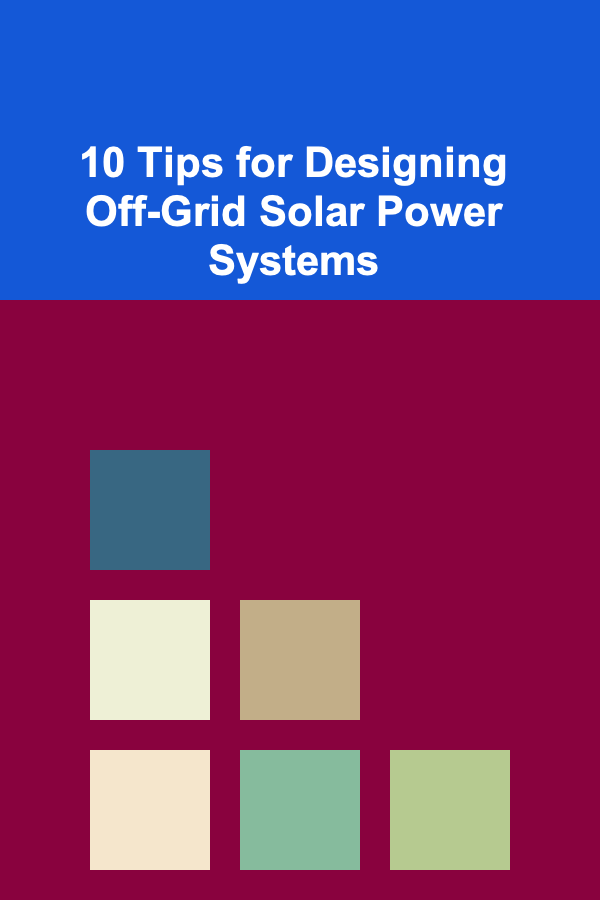
10 Tips for Designing Off-Grid Solar Power Systems
ebook include PDF & Audio bundle (Micro Guide)
$12.99$7.99
Limited Time Offer! Order within the next:

In recent years, the interest in renewable energy sources, especially solar power, has grown exponentially. Among the various solar power applications, off-grid solar power systems are becoming increasingly popular. These systems are used in areas without access to a central power grid or where grid power is unreliable. Off-grid solar systems can be used to power homes, cabins, farms, or remote facilities, offering an independent and sustainable energy solution.
Designing an off-grid solar power system requires careful consideration of multiple factors, from the energy needs of the location to the components of the system. To help guide you through the design process, this article provides 10 essential tips for designing an efficient, reliable, and cost-effective off-grid solar power system.
Assess Your Energy Needs
Before diving into the design of your off-grid solar power system, it is essential to assess your energy needs. This is the foundation of any solar power system, as the design will depend entirely on how much energy you need to produce and store. To begin, consider the following:
- Inventory Your Appliances: List all the appliances and devices you plan to power with the solar system. This can include lights, refrigerators, computers, fans, and other household devices.
- Calculate Power Consumption: Determine the power consumption of each device. You can usually find this information on the appliance's label, often in watts (W). To calculate daily energy consumption, multiply the wattage by the number of hours the device is used each day.
- Estimate Peak Usage: Pay special attention to the peak energy consumption times when multiple devices might be running simultaneously, like during the evening hours when lights, fans, and kitchen appliances are typically in use.
Once you have a clear understanding of your daily and peak energy consumption, you can determine the necessary capacity for your solar panels and battery storage.
Choose the Right Solar Panels
The heart of any off-grid solar power system is the solar panels. Choosing the right panels is crucial to ensure sufficient energy generation, longevity, and efficiency. Here are the key factors to consider when selecting solar panels for your off-grid system:
- Efficiency: Higher efficiency panels generate more power per square meter. While these panels tend to be more expensive, they can be a good option if space is limited or if you have high energy demands.
- Power Output: Panels come in various wattages, typically ranging from 250 to 400 watts. Calculate how many panels you need by dividing your total daily energy requirement by the average daily output of each panel.
- Durability: Since off-grid solar power systems are often located in remote or harsh environments, it's important to select panels that are durable and capable of withstanding extreme weather conditions. Look for panels with robust warranties (typically 20-25 years).
- Temperature Coefficient: Solar panel efficiency can be impacted by temperature. Look for panels with a low temperature coefficient to ensure they perform well in hot climates.
Choosing the right solar panels ensures that your system generates enough energy to meet your needs, even in less-than-ideal conditions.
Size the Battery Storage Appropriately
In an off-grid solar power system, battery storage plays a critical role in ensuring you have a steady supply of power when the sun isn't shining. Sizing your battery storage appropriately is essential for ensuring reliable energy availability.
- Depth of Discharge (DoD): Batteries have a certain DoD, which refers to how much of the battery's capacity can be used without damaging the battery. Lithium-ion batteries typically have a higher DoD (around 80%-90%) compared to lead-acid batteries (50%-60%).
- Battery Capacity: The total capacity of your battery bank will depend on your energy needs and how many days of backup power you want. To calculate this, multiply your daily energy consumption by the number of days of backup power you desire. For example, if your daily consumption is 2 kWh and you want 3 days of backup power, you need a 6 kWh battery bank.
- Battery Type: Choose a battery type that suits your needs and budget. Lithium-ion batteries are more expensive but have a longer lifespan and higher efficiency. Lead-acid batteries are cheaper but require more maintenance and have a shorter lifespan.
Properly sized battery storage ensures that your system can meet your energy needs during the night, cloudy days, or times of increased energy consumption.
Incorporate a Charge Controller
A charge controller is an essential component in any off-grid solar power system. It regulates the voltage and current coming from the solar panels to the batteries, ensuring that the batteries are charged safely and efficiently. Without a charge controller, you risk overcharging the batteries, which can lead to damage, overheating, and even failure.
There are two primary types of charge controllers:
- Pulse Width Modulation (PWM) Controllers: These are simple and cost-effective controllers, ideal for smaller off-grid systems. However, they are less efficient and can result in higher energy losses.
- Maximum Power Point Tracking (MPPT) Controllers: MPPT controllers are more advanced and efficient, particularly for larger systems. They adjust the input from the solar panels to maximize the energy harvested, which increases the overall efficiency of the system.
When selecting a charge controller, consider the size of your solar array, the type of batteries you are using, and the energy generation capacity of your system.
Plan for System Expansion
As your energy needs evolve over time, it's wise to design your off-grid solar power system with future expansion in mind. Whether your family grows, you add more electrical appliances, or you invest in more energy-consuming technologies, you will want to ensure your system can be easily upgraded. Here are some tips to help you plan for system expansion:
- Leave Space for Additional Solar Panels: If you anticipate increased energy demand in the future, you may need to add more solar panels. Leave space for additional panels on your roof or property.
- Choose Expandable Battery Storage: Opt for a battery bank that allows you to add more batteries in the future. This will help you increase your storage capacity if your energy consumption increases.
- Modular Components: Choose modular system components, like charge controllers and inverters, that can be expanded as needed. Modular components allow for easy upgrades without requiring a complete system overhaul.
Planning for expansion ensures that your solar power system can grow with your needs and continue to serve you effectively for years to come.
Install an Inverter for AC Power
While solar panels generate DC (direct current) power, most homes and appliances run on AC (alternating current) power. To convert the DC power from your solar panels into AC power, you need an inverter. Inverters come in different types, depending on the size of your system and your energy needs:
- Pure Sine Wave Inverters: These are ideal for sensitive electronics, like computers and medical equipment, as they provide a smooth, consistent output. They are more expensive but offer higher efficiency and better protection for your appliances.
- Modified Sine Wave Inverters: These are more affordable but provide a less stable power output, which may cause issues with some sensitive electronics. They are generally sufficient for basic appliances like lights and fans.
Make sure to size your inverter appropriately based on your peak power demand. Choosing the right inverter ensures that your system can power all of your AC appliances efficiently.
Evaluate Your Location and Solar Resources
The amount of solar power you can generate is heavily influenced by your location. Solar energy production varies based on geographic location, time of year, weather conditions, and the amount of sunlight you receive. Here's how to evaluate your solar resources:
- Solar Irradiance: Solar irradiance refers to the amount of sunlight reaching the earth's surface, and it varies by location and season. Use online tools like the National Renewable Energy Laboratory's (NREL) solar resource maps to assess the solar irradiance in your area.
- Shading: Shading can significantly reduce the efficiency of your solar panels. When designing your system, evaluate the placement of your panels to avoid areas with trees, buildings, or other obstructions that might cast shadows.
- Tilt and Orientation: The tilt and orientation of your solar panels affect their performance. In most cases, solar panels should face south (in the northern hemisphere) at an angle close to the latitude of your location for optimal energy production.
By understanding your local solar conditions, you can optimize your system's performance and ensure that your panels generate enough energy to meet your needs.
Account for Maintenance and Monitoring
Off-grid solar systems require some maintenance to ensure they operate efficiently and reliably. While solar panels generally require little maintenance, other components of the system, such as batteries, charge controllers, and inverters, need periodic attention.
- Battery Maintenance: If you're using lead-acid batteries, regular maintenance is required to check electrolyte levels and ensure proper charging. Lithium-ion batteries generally require less maintenance.
- Cleaning Panels: Solar panels need to be kept clean to perform optimally. Dust, dirt, and debris can reduce the panels' efficiency. Clean the panels with a soft cloth and non-abrasive detergent to avoid damaging them.
- Monitoring Systems: Consider installing a system to monitor the performance of your solar power system. Many modern charge controllers and inverters come with built-in monitoring systems that provide real-time data on energy production, battery status, and system health.
A well-maintained system will perform more efficiently and have a longer lifespan, reducing the risk of system failures or unexpected downtime.
Implement Energy-Efficient Practices
Designing an off-grid solar power system is only one part of the equation. The other part is using energy efficiently to reduce your overall consumption. By minimizing your energy needs, you can reduce the size and cost of your solar system.
- LED Lighting: Replace incandescent bulbs with energy-efficient LED lights. LED bulbs use a fraction of the energy and last much longer.
- Energy-Efficient Appliances: Invest in energy-efficient appliances with the ENERGY STAR label. These appliances consume less electricity, reducing your energy demand.
- Solar Water Heating: Consider using solar water heaters to reduce the demand for electricity to heat water. This can significantly lower your energy needs.
By incorporating energy-efficient practices, you can make your off-grid solar power system more sustainable and cost-effective in the long run.
Budget for Upfront Costs and Long-Term Savings
Finally, it's important to budget for both the initial investment and long-term savings associated with your off-grid solar system. While the upfront costs can be high, an off-grid solar power system can provide significant savings in the long run, as you will no longer have to pay monthly electricity bills or rely on external energy sources.
Consider the following when budgeting for your system:
- Initial Investment: The cost of the solar panels, batteries, inverters, charge controllers, and other system components will be the largest part of the initial investment.
- Ongoing Maintenance: Regular maintenance, including battery replacements, panel cleaning, and occasional repairs, should be factored into your budget.
- Energy Savings: Calculate how much you will save on electricity bills over time by using solar power. The payback period will depend on your location, energy usage, and system size.
An off-grid solar system can be a significant investment, but the long-term benefits, including energy independence and environmental sustainability, can far outweigh the initial costs.
Designing an off-grid solar power system requires careful planning, research, and attention to detail. By considering factors like your energy needs, solar panel selection, battery storage, and local solar conditions, you can design a system that provides reliable, sustainable energy for your home or remote property. With the right design and maintenance, an off-grid solar system can be an efficient, cost-effective solution that helps you reduce your reliance on traditional energy sources.
Reading More From Our Other Websites
- [Organization Tip 101] How to Create a Stylish Display for Your Fitness Gear
- [Whitewater Rafting Tip 101] From Riverbanks to New Beginnings: Using Rafting as a Metaphor for Personal Reinvention
- [Organization Tip 101] How to Upcycle Household Items for Office Supply Storage
- [Organization Tip 101] How to Organize Your Email Inbox for Better Communication
- [Organization Tip 101] How to Create a Backup Plan to Protect Your Digital Data
- [Organization Tip 101] How to Create a Virtual Filing System That Works
- [Ziplining Tip 101] Best Night‑Time Ziplining Experiences Under a Full Moon
- [Needle Felting Tip 101] Expert Tips for Maintaining and Storing Your Needle Felting Supplies
- [Home Family Activity 101] How to Create DIY Craft Projects for the Whole Family
- [Home Staging 101] How to Stage a Home for a Quick Sale

How to Renovate Your Rental Property for Maximum Appeal
Read More
How To Revive a Language You've Forgotten
Read More
The Risk Manager's Guide: Mastering Risk Assessment and Mitigation Strategies
Read More
How To Understand the Importance of Spaced Repetition
Read More
How to Track Your Investment Performance Across Multiple Brokerages
Read More
How to Navigate Office Politics as a Marketing Coordinator
Read MoreOther Products

How to Renovate Your Rental Property for Maximum Appeal
Read More
How To Revive a Language You've Forgotten
Read More
The Risk Manager's Guide: Mastering Risk Assessment and Mitigation Strategies
Read More
How To Understand the Importance of Spaced Repetition
Read More
How to Track Your Investment Performance Across Multiple Brokerages
Read More